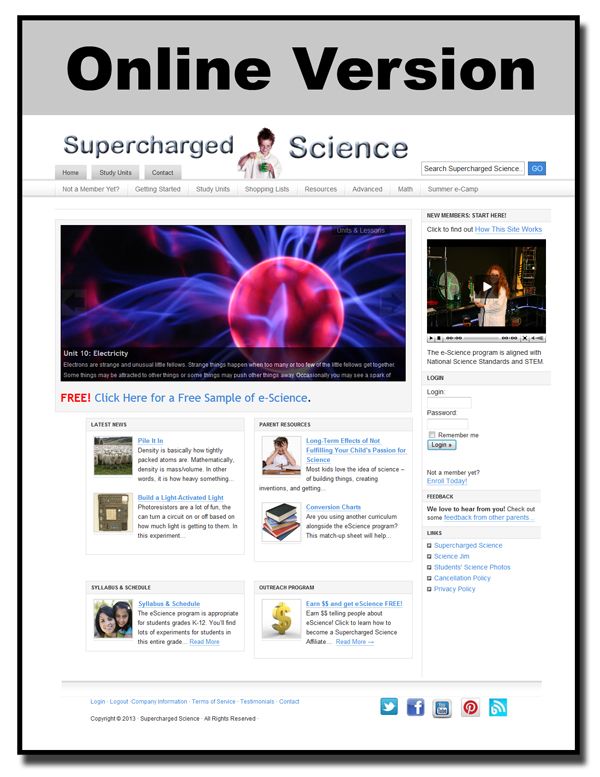Every once in a while a review opportunity comes along that challenges me to move out of my comfort zone. I've always taken a traditional approach to science instruction. I'll read (or assign) a section of a science book to my kids, and then after they are introduced to the concept, I'll consider adding in a science demonstration or experiment to reinforce what we just learned. Often, those hands-on science activities are seen as "extras" and fall by the wayside.
 Supercharged Science uses a completely different way of teaching science, one that's completely opposite of the way I've always done. Their e-Science program starts with the experiments. Not only does it start with experiments, it's all about the experiments.
Supercharged Science uses a completely different way of teaching science, one that's completely opposite of the way I've always done. Their e-Science program starts with the experiments. Not only does it start with experiments, it's all about the experiments.Perhaps the best way to explain their approach is to quote briefly from the The Best Way to Learn Science portion of their website:
We recommend teaching science from the inside-out, meaning that you start with an experiment or two that really hooks your kids . . . the kind that makes them (and you) say: "Wow!" or "Cool!"
Let them roll around and play with the experiment for awhile, and when they come running back to you with questions like "Why did that happen?" or "What's going on here?", then they've signaled you that they are ready for the more academic reading and lesson videos.Shortly after receiving my e-Science subscription, I had Brennan look around at some of the "Getting Started" activities. He first made a flying contraption made of an index card and a straw. He then asked me to find the correct type of water bottle so that he could make the hovercraft pictured below.
One thing that I really appreciated about these materials is that the directions for each experiment are given as short video clips. Although Brennan could read the instructions for an experiment, I know that he's more likely to do the project the way it was designed if he can just watch a video. For students that learn well with videos, some of the lesson materials are also video based.
Many of the science activities only required supplies that were easily found around the house and others were easily found when I was out running my regular errands (at the grocery store, Target, etc). For instance, Brennan explored three different types of levers by using an old board that we found in the backyard, a toolbox, some books, and a heavy box. Many of his other activities used some of the gazillion balls we have thrown in a bag in the garage. The required materials for each unit are conveniently listed in a single shopping list so that I could plan ahead when choosing an area to explore.
The lessons cover both basic concepts and very complex subjects. I've often seen activity ideas suitable for teaching elementary science concepts, but I've never seen so many ideas for teaching high schoolers as there are in this curriculum. Addison helped Brennan with an acceleration demonstration that would've been perfect for her Physical Science class a few years ago. I hoped that I could convince her to do some of the High School level Chemistry experiments as a supplement to the class she is taking this year, but many of those required materials from a chemistry kit that would have to be ordered. Actually, when I looked at the two chemistry units, I realized that Supercharged Science would have given her an excellent high-school level science course. It includes tons of hands-on work as well as readings that remind me of my college textbooks. Perhaps I should've just chosen Supercharged Science in the first place.
We've been using Supercharged Science for about six weeks, and we've probably done more hands-on science in the past six weeks than we did in the past six years combined. This is by far the best way that I've ever seen to add hands-on learning to any science curriculum. Better yet, this program makes it possible to turn science lessons inside-out, focus on doing science (as opposed to reading about science), and create enthusiastic science students. I can't say that I now have budding scientists begging to do science activities every day, but I suspect we all just need more time to wrap our minds around such a completely different approach to our studies.
The activities in e-Science are organized into 20 different units (and a few extra areas such as the scientific method, science fair ideas, parent resources, etc). Online access to all of the materials for Kindergarten through 8th graders is $37 per month, and access to the materials for students in Kindergarten through 12th graders is $57 per month. During the first month of an e-Science subscription, the family gets access to the first 7 units plus the additional extra sections. Each month their subscription continues, they get access to the next 2 units in order. If there is a later unit or two that someone wants to access early, they can send an email requesting access to it immediately so that they do not have to wait for it to be unlocked.
If you would like to try e-Science for yourself, Supercharged Science is giving away a complete mini-program so that you can try some of the activities and see how they work for your kids. You can request the free sample by entering your email address on the Science Activity and Video offer page set up especially for Schoolhouse Review Crew readers.

©2009-2013 Through the Calm and Through the Storm. All rights reserved. Photos and content may not be reproduced. http://throughthecalmandthroughthestorm.blogspot.com






No comments:
Post a Comment